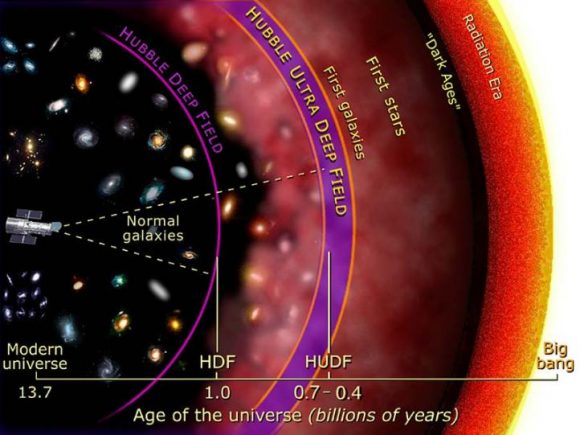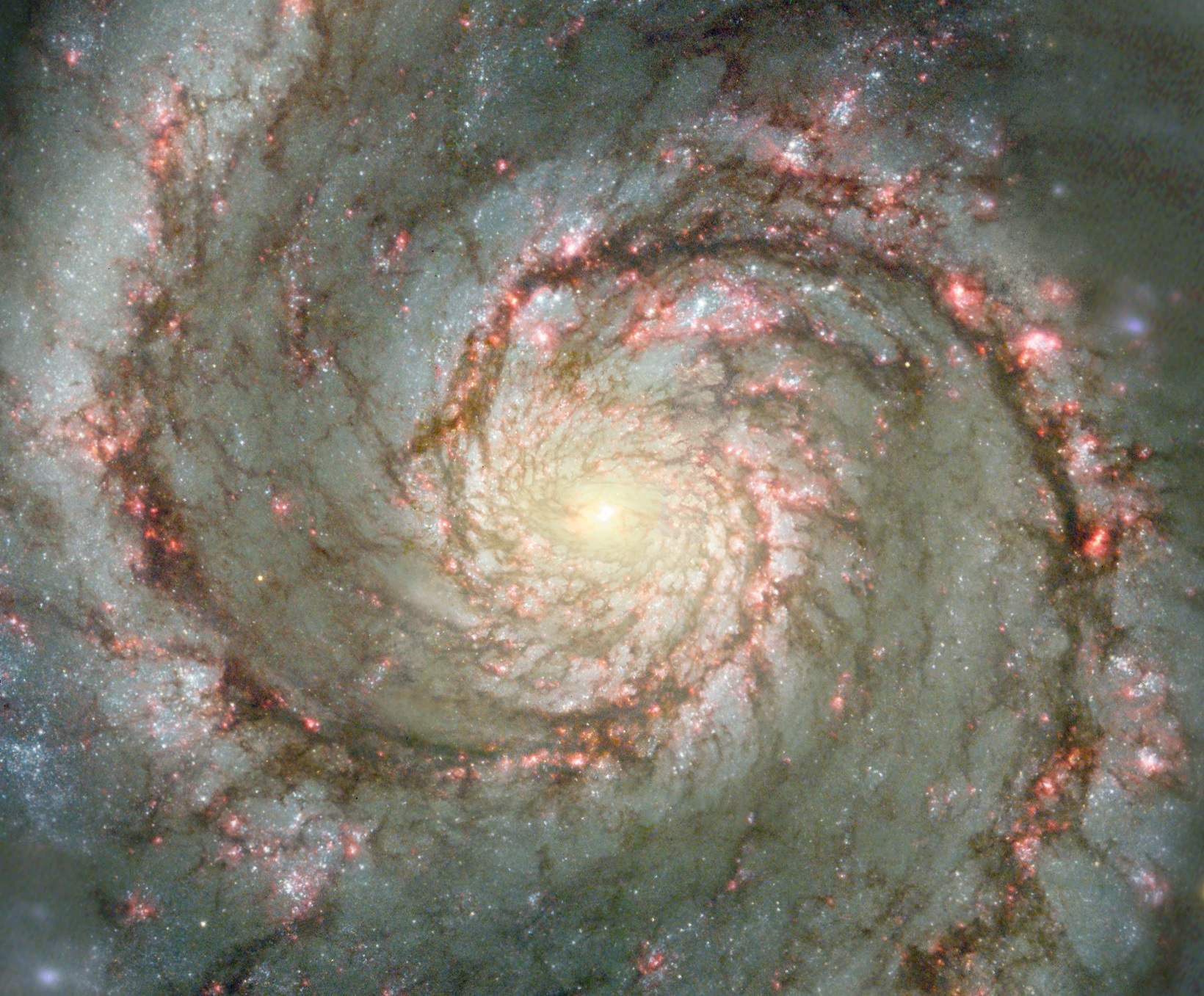On a clear night, you can make out the band of the Milky Way in the night sky. For millennia, astronomers looked upon it in awe, slowly coming to the realization that our Sun was merely one of billions of stars in the galaxy. Over time, as our instruments and methods improved, we came to realize that the Milky Way itself was merely one of billions of galaxies that make up the Universe.
Thanks to the discovery of Relativity and the speed of light, we have also come to understand that when we look through space, we are also looking back in time. By seeing an object 1 billion light-years away, we are also seeing how that object looked 1 billion years ago. This “time machine” effect has allowed astronomers to study how galaxies came to be (i.e. galactic evolution).
The process in which galaxies form and evolve is characterized by steady growth over time, which began shortly after the Big Bang. This process, and the eventual fate of galaxies, remain the subject of intense fascination, and is still fraught with its share of mysteries.

Galaxy Formation:
The current scientific consensus is that all matter in the Universe was created roughly 13.8 billion years ago during an event known as the Big Bang. At this time, all matter was compacted into a very small ball with infinite density and intense heat called a Singularity. Suddenly, the Singularity began expanding, and the Universe as we know it began.
After rapidly expanding and cooling, all matter was almost uniform in distribution. Over the course of the several billion years that followed, the slightly denser regions of the Universe began to become gravitationally attracted to each other. They therefore grew even denser, forming gas clouds and large clumps of matter.
These clumps became primordial galaxies, as the clouds of hydrogen gas within the proto-galaxies underwent gravitational collapse to become the first stars. Some of these early objects were small, and became tiny dwarf galaxies, while others were much larger and became the familiar spiral shapes, like our own Milky Way.
Galactic Mergers:
Once formed, these galaxies evolved together in larger galactic structures called groups, clusters and superclusters. Over time, galaxies were attracted to one another by the force of their gravity, and collided together in a series of mergers. The outcome of these mergers depends on the mass of the galaxies in the collision.
Small galaxies are torn apart by larger galaxies and added to the mass of larger galaxies. Our own Milky Way recently devoured a few dwarf galaxies, turning them into streams of stars that orbit the galactic core. But when large galaxies of similar size come together, they become giant elliptical galaxies.
When this happens, the delicate spiral structure is lost, and the merged galaxies become large and elliptical. Elliptical galaxies are some of the largest galaxies ever observed. Another consequence of these mergers is that the supermassive black holes (SMBH) at their centers become even larger.
Not all mergers will result in elliptical galaxies, mind you. But all mergers result in a change in the structure of the merged galaxies. For example, it is believed that the Milky Way is experiencing a minor merger event with the nearby Magellanic Clouds; and in recent years, it has been determined that the Canis Major dwarf galaxy has merged with our own.
While mergers are seen as violent events, actual collisions are not expected to happen between star systems, given the vast distances between stars. However, mergers can result in gravitational shock waves, which are capable of triggering the formation of new stars. This is what is predicted to happen when our own Milky Way galaxy merges with the Andromeda galaxy in about 4 billion years time.
Galactic Death:
Ultimately, galaxies cease forming stars once they deplete their supply of cold gas and dust. As the supply runs out, star forming slows over the course of billions of years until it ceases entirely. However, ongoing mergers will ensure that fresh stars, gas and dust are deposited in older galaxies, thus prolonging their lives.
At present, it is believed that our galaxy has used up most of its hydrogen, and star formation will slow down until the supply is depleted. Stars like our Sun can only last for 10 billion years or so; but the smallest, coolest red dwarfs can last for a few trillion years. However, thanks to the presence of dwarf galaxies and our impending merger with Andromeda, our galaxy could exist even longer.
However, all galaxies in this vicinity of the Universe will eventually become gravitationally bound to each other and merge into a giant elliptical galaxy. Astronomers have seen examples of these sorts of “fossil galaxies”, a good of which is Messier 49 – a supermassive elliptical galaxy.
These galaxies have used up all their reserves of star forming gas, and all that’s left are the longer lasting stars. Eventually, over vast lengths of time, those stars will wink out one after the other, until the whole thing is the background temperature of the Universe.
After our galaxy merges with Andromeda, and goes on to merge with all other nearby galaxies in the local group, we can expect that it too will undergo a similar fate. And so, galaxy evolution has been occurring over billions of years, and it will continue to happen for the foreseeable future.
We have written many articles about galaxies for Universe Today. Here’s What is the Milky Way?, How did the Milky Way Form?, What Happens When Galaxies Collide?, What Happens When Galaxies Die?, A New Spin on Galactic Evolution, and Supercomputer will Study Galaxy Evolution,
If you’d like more info on galaxies, check out Hubblesite’s News Releases on Galaxies, and here’s NASA’s Science Page on Galaxies.
We have also recorded an episode of Astronomy Cast about galaxies – Episode 97: Galaxies.
Sources:


Once again with the delusional hypothesis. “Galactic Mergers:
Once formed, these galaxies evolved together in larger galactic structures called groups, clusters and superclusters. Over time, galaxies were attracted to one another by the force of their gravity, and collided together in a series of mergers. The outcome of these mergers depends on the mass of the galaxies in the collision.
Small galaxies are torn apart by larger galaxies and added to the mass of larger galaxies. Our own Milky Way recently devoured a few dwarf galaxies, turning them into streams of stars that orbit the galactic core. But when large galaxies of similar size come together, they become giant elliptical galaxies.”
All the system types from ETGs to LTGs are undergoing fission processes starting at an EMERGENT type – that means NOT MERGING. Please stop reinforcing this type of science fiction.
Link here http://ned.ipac.caltech.edu/cgi-bin/INFatt?dom=M&id=2812 and note the topical comment “Observed feature suggest a merging event (theory laden).” Translation: THERE ARE NO “MERGERS” or “collisions.”
I’m certain you can come up with some kind of evidence that galactic fission is occurring, right?
I see a great photo, but no article. ;o(
we just have to wait for evidence at those kind of things